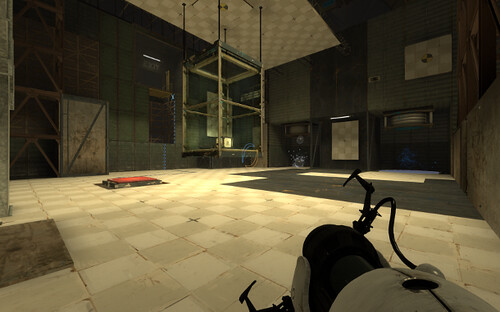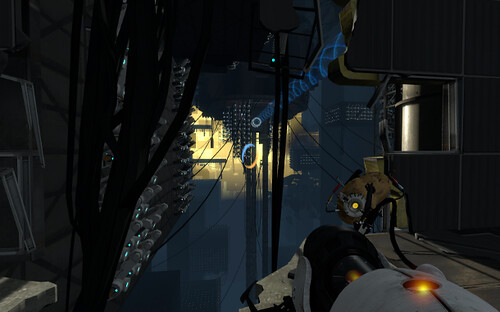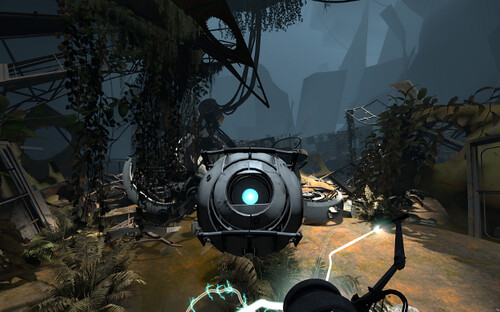Portal 2, like its predecessor, is a puzzle game played in the first-person perspective.
Its origins lie in a student project called Narbacular Drop, where firing two portals at certain types of surfaces would allow to travel between those portals in order to navigate environments that would otherwise be impossible to get through.
The first Portal had more of an emphasis on momentum in its puzzles – where one portal placed on a wall and another in a deep well would result in the player gaining the momentum of falling into the deep well, launching you clear across an entire room upon exiting the portal positioned up on the wall.
You can also launch objects (such as turrets and blocks) in a similar manner, or just carry them through. Sometimes these objects are used to weigh down buttons, others might redirect laser beams that activate doors or somehow allow you to progress further within the game.
Portal 2 goes beyond the original formula, it concerns itself less with the use of portals to launch the player character and more with some new additions, such as jump pads, energy based walkways like those seen in the citadel in Half-Life.

The sequel also introduces three different types of gel that can get sprayed onto various surfaces, one boosts your running speed, the next makes jump/bounce much higher into the air and the third allows you to put portals on surfaces that otherwise wouldn’t be useful for portals.
The structure of the story has changed since the original Portal, with a greater emphasis on characters and the conflict that goes on between them (particularly Wheatley & GLADOS). The original was more about first completing the test chambers created for the player (a subtle yet fun form of long tutorial) before an escape attempt and a showdown with GLADOS.
Jokes about cake are a thing of the past. Instead the humour is more centered around the daftness of Wheatley and snide remarks from GLADOS over her death. Eventually you’ll encounter some other characters that fill in some of the background to the creation of the facility and add some humour of their own to send you on your way.

There’s a strong usage of environmental story telling as well, with the facility showing a great deal of disrepair and nature gradually taking hold over some locations. You’ll often get to see distant glimpses outside the facility along with large vistas that allow you to see the inner workings of the place you’re trapped in. There’s so much space I wanted to see it all.
The puzzles are about as strong as those of the original, with the player going through the stages of trying to figure out where the exit or next area is, then working out how to reach the next set of puzzles. The game is not weaker for this, but I felt quite a bit more constrained in terms of the variety of possible solutions to each puzzle in the sequel, as though the designers had pre-determined specific solutions for you that were less free form. I suspect that some will disagree with this perception.
Ultimately, I enjoyed the relaxed pace, the humour and the challenge of figuring out the solutions to the puzzles. Sometimes the jokes would feel ever so slightly repetitive being broadly along a limited selection of themes. The payoff at the end of the fun single player campaign is worth the effort of completing it.

There’s also a co-op campaign that requires two players to team up and work on solutions together but be aware that this is best experienced by two players who don’t know the solutions and thus aren’t dragging each other around as much.
Mod tools are now available for Portal 2, allowing you to create new places in which to do your portal traversing or play the creations of other people, so there’s bound to be plenty of further challenges waiting to be created.
